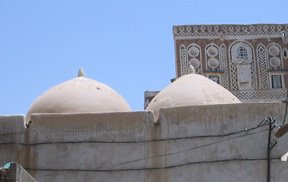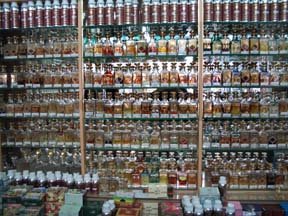Socotra: Heaven and Hell
I'm back early from Socotra. It was one of those Heaven/Hell experiences.
I was hoping to hook up with other tourists and share the cost of a car and driver and guide to get into the backcountry, but it turned out I was the only tourist on the plane. I couldn't afford to go it alone. That' just part of it though. I hadn't counted on the wind, a "dry monsoon", like nothing I've ever experienced. I got off the plane to a relentless strong hot wind. I knew it would be windy, but this was a kind of wind that blows you around in the street, and does not stop, ever. Plastic chairs went skittering down the main street. Then the locals told me, "Oh no, this isn't windy. The real wind hasn't started yet!". On the way in to Hadibo from the airport they pointed out concrete walls that the wind, the real wind, blew down last year. All night the wind screamed and howled and tore at the wall of my hotel. I was drenched in sweat. The next day, the real wind started. Hell.
I was lucky to meet a French woman, Anne, on the plane, who works in Hadibo and she introduced me to one of her local translators, whose father Hamoud offered to take Anne and me up into the mountains overnight because he was going up to visit some family on the Dixam Plateau.
So I did get out of town, if only for two days. It was amazing. The vegetation and landscape are truly otherworldly, and because I was with a local, I had a chance to see more of island Bedouin life than I would have if I had had the luck to be there in tourist season. The wind wasn't so bad in the mountains as it was in Hadibo, and it was chilly and damp.
The family we stayed with set up one of their little stone houses for the men guests and one for the women. I loved the women's guest quarters. It wasa doorless stone structure, with lots of pillows and blankets to cozy up in. We made nests on the floor, and the young women and girls got out the boombox and we had a party, first we danced for a long time. Then one of them got out the cosmetic case and we all got makeovers. One of the women applied our makeup, first a nice dark lipstick, then heavy pale oily pancake makeup, then kohl for our eyes, then plenty of perfume. Then she wanted to put the lipstick on my eyelids, but I begged off, knowing it would last for days. This was all before bed, with no wash water in sight. But it was so much fun! I slept that night knowing I was truly beautiful. For breakfast we had sour, slightly salty goat milk, strange but delicious, like drinking a nice natural cheese. Heaven.
We returned the next day to Hadibo, and I was able to change my ticket to return to the mainland to Monday instead of Friday. I stayed Sunday night with Hamoud's family. I tossed and turned and died a coward's thousand deaths, imagining what it would be like to fly out on Yemenia Airlines in that kind of wind, the kind of wind that grounds air traffic in the rest of the world. All night the wind roared, and whispered "wind shear" into my dreams.
It was a hard trip. I was reminded how much I hate to travel, how hard it is for me to be in wind. The good parts were transcendent, but I'm tired, and it was too much for me. The tough parts were all exhaustion and loneliness, and outweighed the best of it.
That said, please let me add that the people on Socotra were the nicest yet, and that's saying a lot in Yemen. They were welcoming and generous and warm and relaxed and had a wonderful sense of humor and equanimity.
There were, by the way, 8 or 10 American military guys on my plane who made an unintentional comedy of themselves by never giving the same answer twice about what they were doing there. They never let on that they were military, but their dog tags set off airport security, and they all had the same barber. Whadda buncha goofs. They said they were sightseeing, they said they were cave specialists, they said the American embassy had sent them to build a school. It was comic; I thought the first think they taught you at Spook School was to make up a consistent story and stick to it. I shudder to think what they were actually doing there. That's the unfunny part. Socotra is so strategically located, so close to Somalia, so close to Arabia.



